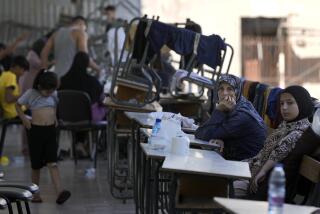Somali Spirit of Enterprise Survives Clan War, Famine : Entrepreneurs: Elite merchants are long gone, but today’s citizens show ability to rebuild a savaged system.
AFGOI, Somalia — Bright and early each brutally hot day in Somalia, Ali Osman Hassan shows up for work in the middle of nowhere, on the rocky road that links Mogadishu with the interior.
Using his hands, Hassan scoops dirt and rocks into a foot-deep pothole, sculpting a smooth, rounded top. As each vehicle approaches, he draws attention to his handiwork by spinning a rolled-up piece of cloth like a cowboy’s lasso over the filled pothole. Then he pauses, hands raised triumphantly and smiling broadly, in a bid for donations.
On a good day, Hassan’s efforts to save the rickety axles and bald tires of Somalia’s trucks earn him about 4,000 shillings from passing motorists. That’s only about 80 U.S. cents, but it’s enough to put food on his family’s table.
“I feel my work is good for the cars,” said Hassan, a 24-year-old in a long gown with a red bandanna wrapped around his head and thongs of tire rubber on his feet. “And I need money for daily life.”
Somalia has been battered by inter-clan warfare and one of the worst famines in modern times. Its 7 million people have no government, no telephones, no airline and not a single operating factory. And yet Hassan and other pothole repairers on the bumpy roads are proof that the entrepreneurial flame indigenous to African society still burns, however dimly, in Somalia.
The elite among Mogadishu’s merchant class fled the nation’s deepening nightmare two years ago. Most of those lucky Somalis with capital are now exiled members of former dictator Mohamed Siad Barre’s Darod clan. They run lamp shops in Djibouti, export firms in Dubai, cab companies in Washington, nightclubs in New York and shops in Nairobi.
But, as the pothole franchisees show each day on the Mogadishu-Baidoa road, many of the Somalis who remained behind are able and willing, with some help from the outside world, to rebuild their savaged and looted nation.
The United Nations, American diplomats and other world leaders hope to fully restore that spirit, beginning with U.S.-led Operation Restore Hope. The operation’s goal is to re-establish security in the country and pave the way for a political settlement among the many warring militias. Only then, the foreign diplomats say, can Somalia begin to rebuild.
“This entrepreneurial spirit is deep in the Somalis,” said Jim Shanor, an American development expert, fluent in the Somali language, who is now on contract to the U.N. Development Program in Mogadishu. “And the spirit lives. These people don’t need much of a push to get going again. It’s in their blood. They just need capital, a lot of capital.”
In the new, fragile calm that has settled over Mogadishu in the days since the Marines landed Dec. 9, impromptu markets have sprung up all over. In the gutted, seaside capital city, dozens of rickety new stands appear with each new day of peace.
Their inventories are low, to be sure, representing the last of their operators’ disposable possessions after the national looting spree that stripped Mogadishu bare. The street fare includes ancient and rusted nuts, bolts, screws, nails, hinges, pulleys and springs--just the things that the 1 million residents of Mogadishu will need for a few minor post-civil-war household repairs.
On a recent day, one old man waving flies from his face crouched behind a tiny table that offered just seven pencils and an old ballpoint pen. No schools or offices are left in the capital. Most were gutted in a ferocious, four-month artillery duel between Mogadishu’s warring clan leaders. But the new peace is just the thing, the African capitalists figure, to get the kids back in school. And students need pencils.
Even during the daily storm of artillery and mortar shells that tore so deeply into Mogadishu’s foundation, an era of horror that flooded the capital with refugees in makeshift camps and adjacent fields with shallow graves, the Somali genius to jury-rig never died.
Tens of thousands of residents of the capital, for example, live in huts of corrugated tin, which they salvaged from the roofs and walls of bombarded buildings when their own homes were destroyed. When the Marines retook the abandoned U.S. Embassy compound Dec. 10, they found the place stripped of nearly every scrap of metal.
The survival instinct behind such activity was what U.N. development experts harnessed when they were looking for a way to maintain minimal sanitation services in a daily urban war zone. With a little capital, the U.N. Development Program hired a small army of cart-pushers, rendered jobless by the city’s absence of commerce. Each one now has his own small block to clean and a designated central dumping spot.
A metaphor for the Somalian economy is the Central Bank building, a gutted and shell-pocked structure right at the downtown Green Line that divides the territories of Mogadishu’s two biggest warlords.
The crumbling building, in the heart of the city’s dangerous “Bermuda Triangle,” is a gravestone to Siad Barre’s corrupt rule and his final, desperate effort to cling to power by force.
During the last years of Siad Barre’s reign in 1987, before breakaway army officers rebelled, drove him into exile in January, 1991, and filled the power vacuum with anarchy, Siad Barre doled out an estimated 8 billion Somali shillings (about $16 million) in unsecured loans to win friends and favor. Most of the beneficiaries, to no one’s surprise, were from the president’s clan, which ultimately spirited most of the money out of the country.
Inflation soared, wages fell and the currency collapsed. A Somali could buy a U.S. dollar for 500 shillings at the time. When Siad Barre left, the value of the dollar was 7,000 shillings, and imported goods were beyond the reach of all but the wealthiest.
“There was a strong middle class, but it really collapsed under Siad’s time,” said Mohamed Jirdeh, son of a prominent city elder who is among the handful of Somali businessmen from the wealthy elite class that stayed in Mogadishu.
“That was Siad Barre’s biggest and worst failure,” Jirdeh added. “It drove out the doctors, the professionals, the officers, the technocrats. Anyone who could get out got out when they could.”
Property values collapsed. Firms were destroyed. And the middle class disappeared virtually overnight.
“People lived off their savings. Still, they are living off their savings,” Jirdeh said. “But for most, everything is gone.”
Jirdeh said there are still small amounts of capital in town to refurbish houses and open small businesses like tea stalls, car repair shops and street vending stands.
But big capital?
“Not much,” he said. “Of course, there is a lot of capital with the looters. They make money. But, when their guns are taken away, I think many will leave.”
The two-year looting binge sucked up as much as half the international relief assistance sent to Somalia to save it from famine. And it fueled a wartime economy that benefited only the criminals.
At the Bakara Market, a choked and muddy warren of lanes so narrow that there are people jams throughout the day, private warehouses are packed floor to ceiling with bags of American wheat and rice. So arrogant have the looters been that they have seen no need to remove the labels, and the booty is openly trucked around town on the beds of small pickups.
Currency traders stand beside boxes brimming with stacks of paper shillings, as hundreds of gunmen hired by relief agencies for “technical assistance” shake fists of hundred-dollar bills and argue for a better exchange rate.
“The economy in Somalia is not normal,” said John Marks, an American relief official who has spent time in Somalia off and on since 1968.
It has become even stranger since the U.S. forces arrived and the world’s attention became focused here. The arrival of hundreds of journalists has given the economy a temporary shot in the arm. Dilapidated villas have been rented for upward of $3,000 a month, cooks and housekeepers have found jobs, and Somalis with vehicles are escorting the visitors around town for $150 and more a day.
So many U.S. dollars are flooding the country that the greenback lost 50% of its value against the local shilling on the day the Marines arrived. Gasoline prices tripled overnight, to $14 a gallon. And in neighboring Kenya, where journalists and relief workers load up on American currency for the journey to Somalia, banks are reporting a shortage of greenbacks.
At Bakara Market, a principal outlet for looted merchandise, the new money coming into the country has helped stage a dizzying display of Somali capitalist savvy.
The other day a photographer sat behind a half-century-old view camera and insisted he still had enough chemicals to develop a customer’s film. A bookseller hawked textbooks and old novels in Italian, the language of Mogadishu’s colonial rulers until its independence 32 years ago. There also were books in English on computer programming and hundreds of second-hand household appliances.
Most Somalis seem eager--and even impatient--for a new era of economic activity in their land. Armed to the teeth only a few weeks ago, many now see the U.S. forces patrolling the streets as a harbinger of peace and, more importantly, jobs.
Dahir Jimale, who heads a 40-man militia guarding the southern side of the Green Line in Mogadishu, said recently that he was ready to hand over his weapon and abandon his post in exchange for honest work.
“You people have been called to be in Somalia,” Jimale told an American. “When are you going to reopen the factories for us?
“All of us who are fighting are not really soldiers,” added Jimale, who was a truck driver before the civil war. “Most of us are mechanics, hotel managers and students. We want to go back to work.”
More to Read
Sign up for Essential California
The most important California stories and recommendations in your inbox every morning.
You may occasionally receive promotional content from the Los Angeles Times.











